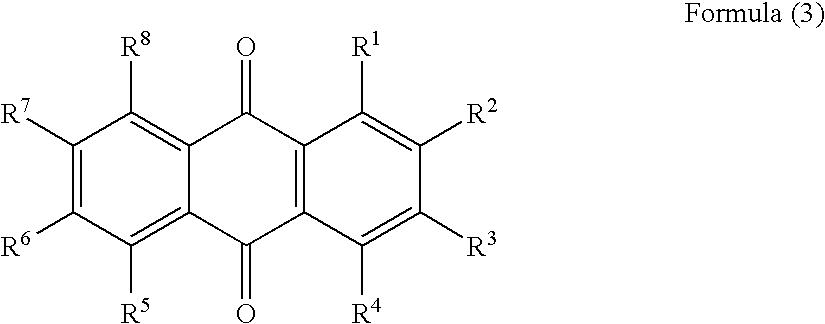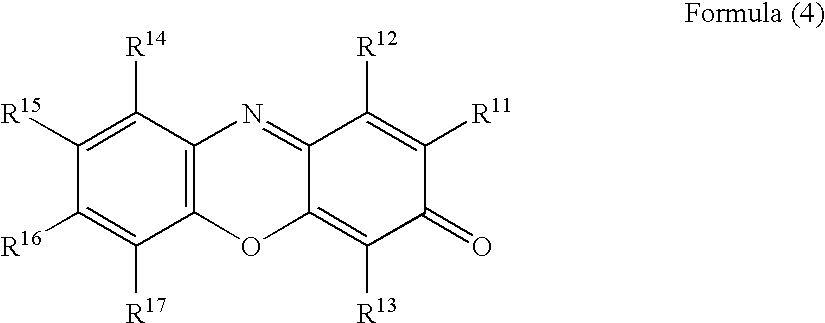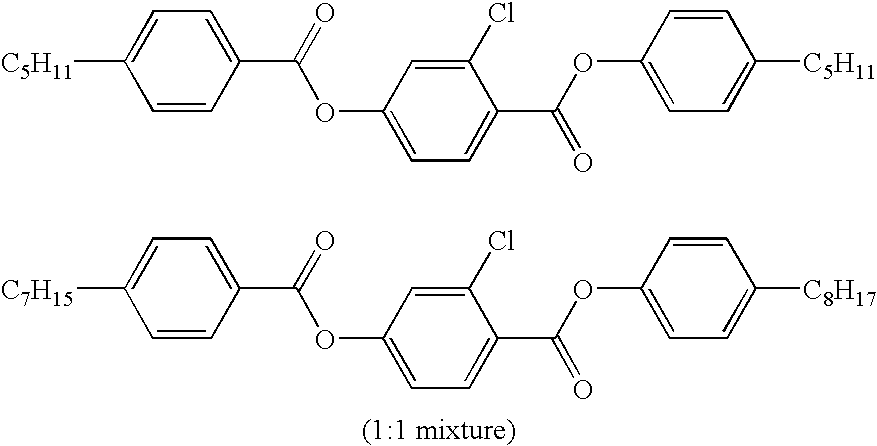Liquid crystal composition and liquid crystal element
a technology of liquid crystal elements and compositions, applied in the direction of liquid crystal compositions, thin material processing, chemistry apparatus and processes, etc., can solve the problems of inability to store image information without electrical fields, and inability to show a low consumption of electric power to be required, so as to achieve the effect of simplifying the structure and free from lowering the display properties
- Summary
- Abstract
- Description
- Claims
- Application Information
AI Technical Summary
Benefits of technology
Problems solved by technology
Method used
Image
Examples
example 1
(Synthesis. No. 1 of Smectic Liquid Crystal)
[0173] Smectic liquid crystal (1) was prepared according to a scheme shown below.
(Synthesis of Compound 1a)
[0174] A 600 ml of acetonitrile solution of 4-hydroxy benzoic acid (30 g) (manufactured by TOKYO CHEMICAL INDUSTRY CO., LTD.) and CsF-Celite (109.4 g), which was prepared according to a method described in SYNTHETIC COMMUNICATIONS, 28(11), 2021-2026 (1998) was added dropwise with 74. 3 g of benzyl bromide, and was stirred under reflux for three hours. The reaction solution was condensed under reduced pressure, added with 500 ml of ethyl acetate, and filtered. The filtrate was condensed under reduced pressure, and the condensed residue was recrystallized in a mixed solvent of water and methanol to yield a crude crystal. The crude crystal was recrystallized in toluene to yield 31 g of Compound 1a.
(Synthesis of Compound 1b)
[0175] A 50 ml of methylene chloride of Compound 1a (4 g) and 4-n-undecyloxy benzoic acid (5.1 g) (manufact...
example 2
(Preparation of Liquid Crystal Composition No. 1)
[0185] A mixture of 5 mg of Dichroic Liquid Crystal (1-8), 14.8 mg of Smectic Liquid Crystal (1), 75.8 mg of Dual-frequency Switchable Nematic Liquid Crystal (H-1), which is described in Applied Physics Letters, Vol. 25, 186-188(1974), and 9.4 mg of Liquid Crystal (H-2),having a negative Δε, was heated on a hot plate of 180° C. for one hour, cooled down to a room temperature, and left overnight. Thus, Liquid Crystal Composition No. 1 was obtained.
(Preparation of Liquid Crystal Composition No. 2)
[0186] Liquid Crystal Composition No. 2 was prepared in the same manner as Liquid Crystal Composition No. 1, except that 1 mg of Dichroic Dye (1-14) was used in the place of 5 mg of Dichroic Dye (1-8).
(Preparation of Liquid Crystal Composition No. 3)
[0187] Liquid Crystal Composition No. 3 was prepared in the same manner as Liquid Crystal Composition No. 1, except that Smectic Liquid Crystal (5) was used in the place of Smectic Liquid C...
example 3
(Production of Liquid Crystal Device)
[0193] Each of Liquid crystal device Nos. A to H was produced by pouring each of Liquid Crystal Composition Nos. 1 to 8 in a commercially available liquid crystal cell at 180° C. The liquid crystal cell employed was a glass substrate (thickness of 0.7 mm) manufactured by E.H.C. and having an ITO transparent electrode layer, and had a cell gap of 8 μm and an epoxy resin seal. It is to be noted that any alignment layer was not formed on the ITO transparent electrode layer.
[0194] Applying a square wave AC voltage with low frequency (100V, 100 Hz) to each of Liquid crystal device Nos. A to H, the optical transmittance was measured using a spectrometer, “UV-2400PC” manufacture by Shimazu Corporation. Next, applying a square wave AC voltage with high frequency (100V, 100 kHz) to each of Liquid crystal device Nos. A to H, the optical transmittance was measured in the same manner. Each of liquid crystal devices was allowed to stand for a week after tu...
PUM
| Property | Measurement | Unit |
|---|---|---|
| molar ratio | aaaaa | aaaaa |
| thickness | aaaaa | aaaaa |
| thickness | aaaaa | aaaaa |
Abstract
Description
Claims
Application Information
 Login to View More
Login to View More - R&D
- Intellectual Property
- Life Sciences
- Materials
- Tech Scout
- Unparalleled Data Quality
- Higher Quality Content
- 60% Fewer Hallucinations
Browse by: Latest US Patents, China's latest patents, Technical Efficacy Thesaurus, Application Domain, Technology Topic, Popular Technical Reports.
© 2025 PatSnap. All rights reserved.Legal|Privacy policy|Modern Slavery Act Transparency Statement|Sitemap|About US| Contact US: help@patsnap.com



